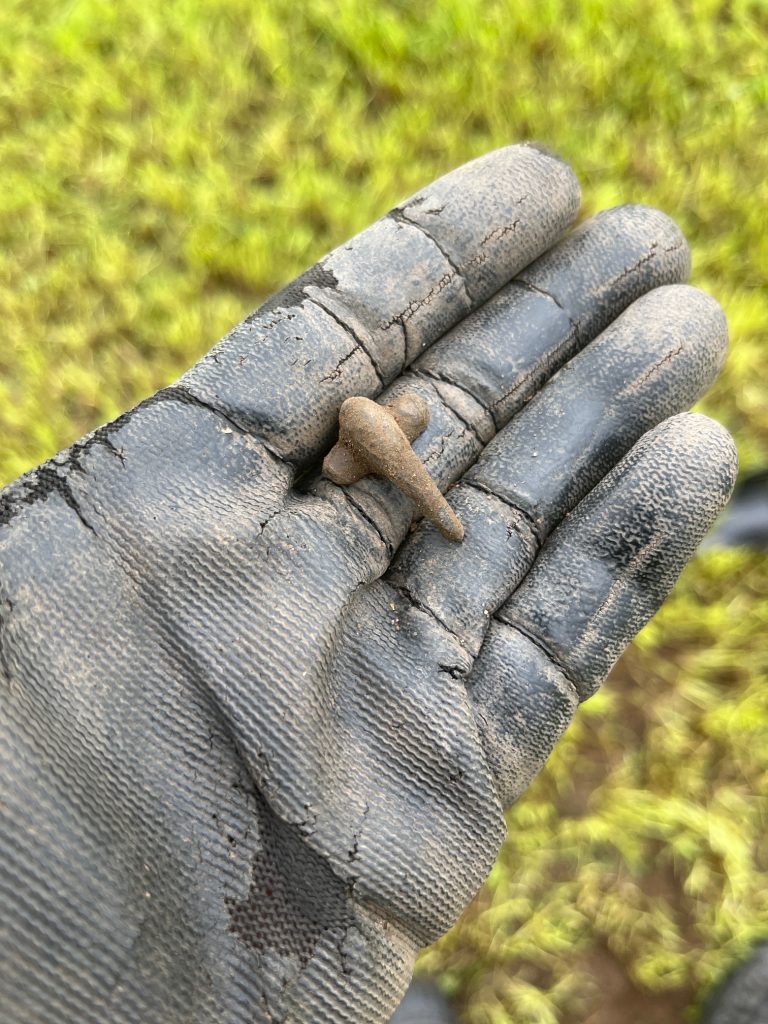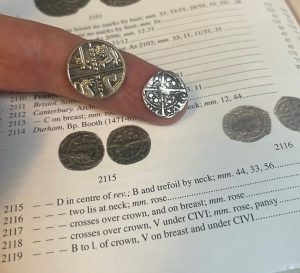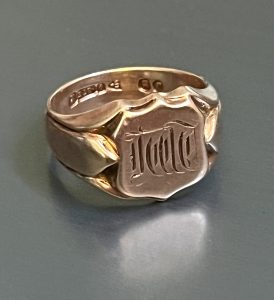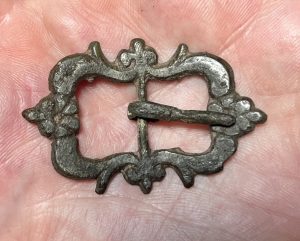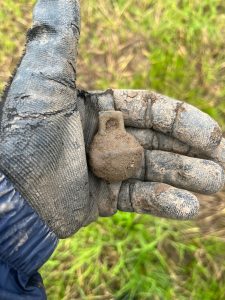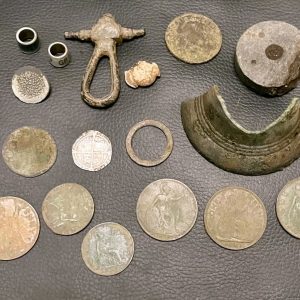
I don’t know about you, but despite living in an area with a known Roman history, I never seem to find anything Roman whilst out detecting. That is, until this little beauty popped up. It’s funny how metal detecting works – you can spend years searching in historically rich areas without a sniff of anything ancient, and then suddenly, out of nowhere, a piece of history emerges from the soil. It’s moments like these that keep us detectorists coming back, trudging through fields in all weather, hoping for that one special find.
Exploring Prime Metal Detecting Locations: My Top 5 Favourite Fields
This particular find was made on one of my favourite fields to detect on. I probably have about 5 favourite fields where something interesting usually shows up. Each of these fields has its own character and history, and I’ve come to know them like old friends. There’s the one near the old manor house, the riverside field that’s given up some lovely medieval coins, and the hilltop field with views for miles – each one holds the promise of hidden treasures. I hope I haven’t jinxed it for future detecting days out now by mentioning that! You know how superstitious we detectorists can be – it’s almost like the metal detecting gods are listening, ready to punish any hint of boastfulness with a run of blank days.
Seizing the Perfect Moment: Detecting After a Fresh Grass Cut
It was August earlier this year when this all happened. I had driven past the field the day before and noticed that the grass had only just been cut. Any detectorist worth their salt knows that’s prime time for a search, so me and Bob decided to get on it straight away. There’s something special about detecting on a freshly cut field – the grass is short, making it easier to swing your detector close to the ground, and any rain can wash off the cut grass, potentially exposing items that were previously hidden. Plus, there’s always the chance that the mowing process itself might have brought something to the surface. We were like kids on Christmas morning, eager to see what gifts the field might have for us.
The Usual Suspects: Common Finds in Metal Detecting
We set about generally wandering about on this field, finding the usual pre-decimal coins and buttons and the inevitable bits of scrap that you can’t avoid when metal detecting. I found some sort of pocket watch chain fob item, a spindle whorl and a musket ball. All very interesting but nothing too amazing. These are the kinds of finds that make up the bread and butter of metal detecting – not particularly valuable or rare, but each with its own story to tell. The pocket watch fob might have belonged to a Victorian gentleman, the spindle whorl to a medieval housewife, and the musket ball could have been fired in some long-forgotten skirmish. It’s these everyday items that build up our understanding of the past, piece by piece.
The Moment of Discovery: Unearthing a Roman Fibula
Then right in the middle of the field, I had a pretty decent signal. You know the kind – not too loud, but clear and consistent, the sort that makes your heart beat a little faster. I dug out a nice round plug and checked with my detector to see if it had come out with the plug or if it was still in the hole. It was still in the hole, so I used my pinpointer to see where it was. It was right in the centre somewhere, just a little deeper in the ground. This is always an exciting moment – you know you’re close to your target, but you still don’t know what it is. Could it be another button? A coin? Or something more interesting?
I used my digging tool to gently loosen the compacted soil around the area indicated then scooped out a handful of the loosened soil. I immediately felt something hard and metallic in my hand. There’s a special thrill in that moment when you first touch a find – it’s been waiting in the ground for who knows how long, and you’re the first person to hold it in centuries. I opened my hand and saw it just sitting there, covered in soil but unmistakably something special.
Recognizing Roman Artifacts: Identifying a Fibula Brooch
I knew what it was straight away. I had never found one before, but had seen enough photos of them to know that it was a Roman brooch fibula. It’s amazing how quickly your brain can process these things – one moment you’re looking at a dirt-covered object, the next you’re mentally flicking through all the images of artifacts you’ve ever seen, trying to make a match. Me and Bob give each other a shout if we find something interesting. We’ve developed a whole code over the years – a shout of “Hi Ho!” means Silver, “I’m dancing” means gold (sadly we don’t use that one very often), “Medieevalll!” means just that. It’s our way of sharing the excitement of a find without having to traipse across the field every time.
However, this time I was in shock. I didn’t know what to shout so after a moment I just kind of squeaked “fibula…” We do have a running joke about some metallic finds being “fibula-esque”, but of course they never were an actual fibula. It’s become a bit of an in-joke between us, a way of dealing with the disappointment of finding yet another unidentifiable bit of metal. But this time, it wasn’t a joke at all.
Sharing the Excitement: Reactions to a Rare Find
Bob wasn’t sure what I had said so just said “what’s that?”. I had composed myself by then and shouted “fibula!”. He just laughed and said “yeah right..” I said no, I mean it I have found an actual fibula. You could hear the disbelief in his voice – after all our jokes about “fibula-esque” finds, it was hard to believe we’d actually found one. He dropped everything and hurried across to me and I dropped it into his hand. It’s moments like these that make metal detecting such a great hobby – the shared excitement, the disbelief turning to joy, the chance to hold a piece of history that’s been hidden for centuries.
It is tiny but there was no doubt that it was a very small Roman fibula brooch, probably a child’s. He congratulated me on my find (well in a sort of friendly but begrudging way) and I placed it in my coin pod and we continued to detect. That’s the thing about detecting – no matter how amazing your find, you always keep going, hoping for more. But we both knew that this little brooch was something special, a find that doesn’t come along every day.
The Day’s Conclusion: Celebrating and Securing New Permissions
As usual, nothing else that we found that day came close to the fibula. It’s often the way – you have one standout find and everything else pales in comparison. So at the end of the day, after a few pints in the local pub (where the barmaid told us that she had got us a new permission at the next farm along from this one) I headed home to gently clean and photograph the fibula. The pub stop is as much a part of our detecting routine as the detecting itself – a chance to relax, review our finds, and share stories. And getting news of a new permission was the cherry on top of an already great day. It’s always exciting to have a new area to explore, full of potential finds waiting to be discovered.
Dating and Identifying the Roman Fibula: Expert Opinions
After posting photos online, the general consensus was that it is indeed a child’s fibula brooch, probably dating to the 1st or 2nd Century. It’s amazing to think that this tiny piece of metal was last worn by a child nearly two thousand years ago. Who was this child? What was their life like? We’ll never know the full story, but finds like these help us piece together the puzzle of the past. So that makes it my first ever fibula, and my first ever Roman find. It’s a milestone in my detecting career, a tangible link to the Roman history of our area that I’ve known about but never personally encountered.
It just goes to show that persistence pays off in this hobby. You never know when you might stumble upon a piece of history that’s been hiding right under your feet for centuries. Every time you swing that detector, you’re not just searching for metal – you’re reaching back through time, hoping to make a connection with the people who lived, worked, and walked on the same ground centuries ago. So keep at it. Your next amazing find could be just one swing away.






